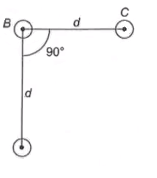
An arrangement of three parallel straight wires placed perpendicular to a plane of paper carrying the same current ‘I’ along the same direction is shown in figure. Magnitude of force per unit length on the middle wire ′B′ is given by

(A) $\dfrac{{{\mu _0}{i^2}}}{{\sqrt 2 \pi d}}$
(B) $\dfrac{{{\mu _0}{i^2}}}{{2\pi d}}$
(C) $\dfrac{{2{\mu _0}{i^2}}}{{\pi d}}$
(D) $\dfrac{{\sqrt 2 {\mu _0}{i^2}}}{{\pi d}}$
Answer
218.7k+ views
Hint: We can use Biot-savart law to get the magnetic field at some distance due to a conducting straight wire and use the relation between magnetic field and force to calculate the magnetic force per unit length.
Formula used:
$\overrightarrow F = i(\overrightarrow l \times \overrightarrow B )$
Complete step by step answer:
It is given that there are three wires kept perpendicular to the plane of paper, so we can use biot sarvart law to calculate magnetic fields due to these straight wires.
$B = \dfrac{{{\mu _0}}}{{2\pi }}\dfrac{i}{R}$gives the magnetic field B at distance R from a current carrying conductor
So magnetic field on point A will be ${B_A} = \dfrac{{{\mu _0}}}{{2\pi }}\dfrac{i}{d}$
And magnetic field on point C will be ${B_C} = \dfrac{{{\mu _0}}}{{2\pi }}\dfrac{i}{d}$
And we know that $\overrightarrow F = i(\overrightarrow l \times \overrightarrow B )$ where F is the force on the conductor of l length carrying I amount of current when placed in ‘B’ magnetic field.
Here, let us suppose the force on point B due A is $\overrightarrow {{F_{BA}}} $ so,
$\dfrac{{{F_{BA}}}}{l} = i{B_A} = i\dfrac{{{\mu _0}}}{{2\pi }}\dfrac{i}{d} = \dfrac{{{\mu _0}}}{{2\pi }}\dfrac{{{i^2}}}{d}$, we can find the direction by Fleming’s left hands rule we will get downward direction
suppose the force on point B due C is $\overrightarrow {{F_{BC}}} $ so,
$\dfrac{{{F_{BC}}}}{l} = i{B_C} = i\dfrac{{{\mu _0}}}{{2\pi }}\dfrac{i}{d} = \dfrac{{{\mu _0}}}{{2\pi }}\dfrac{{{i^2}}}{d}$ by Fleming’s left hands rule we will get the direction along BC
So, the net magnetic force per unit length will be ${F_{net}} = \sqrt {|{F_{BA}}{|^2} + |{F_{BC}}{|^2}} = \sqrt 2 \dfrac{{{\mu _0}}}{{2\pi }}\dfrac{{{i^2}}}{d} \approx \dfrac{{{\mu _0}}}{{\sqrt 2 \pi }}\dfrac{{{i^2}}}{d}$
Hence, the correct option is A
Note:
Fleming's left hand rule can be used to find the direction of force on a current carrying conductor when placed in a magnetic field. It states that when the fore-finger, the middle one and the thumb are placed mutually perpendicular to each other , where the fore-finger shows magnetic field direction , the middle finger shows the current flowing then the direction in which the thumb points will give the direction of magnetic force.
Formula used:
$\overrightarrow F = i(\overrightarrow l \times \overrightarrow B )$
Complete step by step answer:
It is given that there are three wires kept perpendicular to the plane of paper, so we can use biot sarvart law to calculate magnetic fields due to these straight wires.
$B = \dfrac{{{\mu _0}}}{{2\pi }}\dfrac{i}{R}$gives the magnetic field B at distance R from a current carrying conductor
So magnetic field on point A will be ${B_A} = \dfrac{{{\mu _0}}}{{2\pi }}\dfrac{i}{d}$
And magnetic field on point C will be ${B_C} = \dfrac{{{\mu _0}}}{{2\pi }}\dfrac{i}{d}$
And we know that $\overrightarrow F = i(\overrightarrow l \times \overrightarrow B )$ where F is the force on the conductor of l length carrying I amount of current when placed in ‘B’ magnetic field.
Here, let us suppose the force on point B due A is $\overrightarrow {{F_{BA}}} $ so,
$\dfrac{{{F_{BA}}}}{l} = i{B_A} = i\dfrac{{{\mu _0}}}{{2\pi }}\dfrac{i}{d} = \dfrac{{{\mu _0}}}{{2\pi }}\dfrac{{{i^2}}}{d}$, we can find the direction by Fleming’s left hands rule we will get downward direction
suppose the force on point B due C is $\overrightarrow {{F_{BC}}} $ so,
$\dfrac{{{F_{BC}}}}{l} = i{B_C} = i\dfrac{{{\mu _0}}}{{2\pi }}\dfrac{i}{d} = \dfrac{{{\mu _0}}}{{2\pi }}\dfrac{{{i^2}}}{d}$ by Fleming’s left hands rule we will get the direction along BC
So, the net magnetic force per unit length will be ${F_{net}} = \sqrt {|{F_{BA}}{|^2} + |{F_{BC}}{|^2}} = \sqrt 2 \dfrac{{{\mu _0}}}{{2\pi }}\dfrac{{{i^2}}}{d} \approx \dfrac{{{\mu _0}}}{{\sqrt 2 \pi }}\dfrac{{{i^2}}}{d}$
Hence, the correct option is A
Note:
Fleming's left hand rule can be used to find the direction of force on a current carrying conductor when placed in a magnetic field. It states that when the fore-finger, the middle one and the thumb are placed mutually perpendicular to each other , where the fore-finger shows magnetic field direction , the middle finger shows the current flowing then the direction in which the thumb points will give the direction of magnetic force.
Recently Updated Pages
A square frame of side 10 cm and a long straight wire class 12 physics JEE_Main

The work done in slowly moving an electron of charge class 12 physics JEE_Main

Two identical charged spheres suspended from a common class 12 physics JEE_Main

According to Bohrs theory the timeaveraged magnetic class 12 physics JEE_Main

ill in the blanks Pure tungsten has A Low resistivity class 12 physics JEE_Main

The value of the resistor RS needed in the DC voltage class 12 physics JEE_Main

Trending doubts
JEE Main 2026: Application Form Open, Exam Dates, Syllabus, Eligibility & Question Papers

Derivation of Equation of Trajectory Explained for Students

Hybridisation in Chemistry – Concept, Types & Applications

Understanding the Angle of Deviation in a Prism

Understanding Collisions: Types and Examples for Students

Understanding Atomic Structure for Beginners

Other Pages
JEE Advanced Marks vs Ranks 2025: Understanding Category-wise Qualifying Marks and Previous Year Cut-offs

How to Convert a Galvanometer into an Ammeter or Voltmeter

Understanding Centrifugal Force in Physics

Ideal and Non-Ideal Solutions Explained for Class 12 Chemistry

Degree of Dissociation: Meaning, Formula, Calculation & Uses

Understanding Electromagnetic Waves and Their Importance




